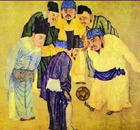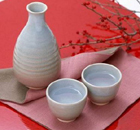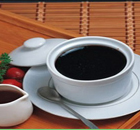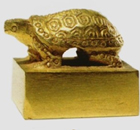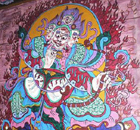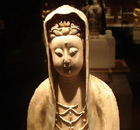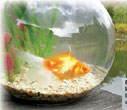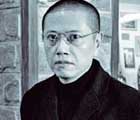Heritage
The temple, family cemetery and family mansion of Confucius (Kong-zi) in Qufu (Qufu, Shandong province)
(chinaculture.org)
Updated: 2008-02-15 09:07
 |
Large Medium Small |
Brief Introduction
These sites, over 2,000 years old, are links with China's most famous sage and educator.
Covering 140,000 sq. m, the site boasts over a hundred halls, towers, pavilions and other buildings clustering around 9 courtyards. There are also the Apricot Altar on the spot where Confucius had his school, the famous cypress planted by him and over 1,000 stone tablets.
To the east of the temple is Confucius' house. During the Han Dynasty, Emperor Gaozu conferred official titles on all Confucius' descendants, and his ancestral home was honored. It has 480 rooms, which contain a large number of relics connected with the sage.
Located north of Qufu, the Confucius Forest is where the tombs of Confucius and many of his descendants are to be found. Zi Gong, one of Confucius' leading disciples, started planting trees at his master's tomb, and now there are over 10,000 trees here. Kong Shangren, author of the drama The Peach Blossom Fan, is buried here too.
Cultural Heritage
The Temple of Confucius in Qufu is the central temple for worshippers of Confucius all over the world and model to over 2000 Confucius temples distributed in China, Korea, Japan, Vietnam, Indonesia, Singapore, the United States and other places. It has been in use for over 2,400 years.
The Cemetery of the Kong family, also with a history of over 2,400 years, is one of the oldest in the world.
The Family Mansion of Confucius is the largest, most typical and best-preserved special building complex for both official and private use still existent in China. Its owner, the Kong family, is the most time-honored noble family of China, with peerage titles dating back over 2,100 years.
The historic, scientific and artistic value of the Temple, Family Cemetery and Family Mansion of Confucius lie in their impressive collection of cultural relics. In the field of architecture, more than 300 buildings erected through the Jin, Yuan, Ming and Qing dynasties reflect the characteristics of those different eras. Over 1,000 Han Dynasty stone reliefs, inscribed figures of Confucius and dragon poles illustrate the evolution of the art of stone inscription. Over 5,000 inscribed tablets passed down since the Western Han Dynasty provide a precious showcase of Chinese calligraphy as well as valuable material for the study of ancient China's politics, ideology, economy, culture and arts. Some 100,000 tombs bear concrete testimony to the ancient burial customs of China. In addition, more than 17,000 ancient and precious trees stand here as living material for research into ancient phenology, meteorology and bionomics. There are also 100,000-plus items of collected relics, among which the most famous are rare genuine costumes of the Yuan and Ming dynasties, portraits of Confucius, Lord Yansheng and their wives, as well as original ceremonial utensils. Researchers into the study of history, especially the economic history of the Ming and Qing dynasties cannot miss the 300,000 original files and documents of those times, which comprise the largest private collection of ancient files in China.
Confucius and Confucianism
Confucius (551-479 BC) was China's most famous philosopher, political theorist, statesman and educator.
Born in the State of Lu towards the end of the Spring and Autumn period prior to the Warring States, an age of much conflict and unrest, he spent his whole life in the pursuit of learning (xue) and truth, and practiced a self-disciplined life, exerting a far-reaching influence on the mentality of the Chinese people and many other peoples around the world.
Confucius sought learning extensively, from the six arts(ritual, music, archery, charioteering, calligraphy, and arithmetic) to the thoughts of Laotsu (Lao-zi, founder of Taoism). He held several posts, from finance officer to Minister of Justice. He traveled to many states to propagate his political thought, and set up and presided over the earliest Chinese school open to all classes of people. He was the chief compiler and editor of many historical records as well as some of the most influential books of Chinese history, including The Book of Songs (Shi-jing) and The Spring and Autumn Annals (Chun-qiu). His own thoughts are collected in the Analects of Confucius (Lun-yu), complied by his disciples.
One of Confucius' most significant personal descriptions is the short autobiographical account of his intellectual development found in the Analects:
At 15 I set my heart on learning; at 30 I firmly took my stand; at 40 I had no delusions; at 50 I knew the Mandate of Heaven; at 60 my ear was attuned; at 70 I followed my heart's desire without overstepping the boundaries of righteousness. (2:4)
Confucius' thought, centered onren (humanity or benevolence), was mostly a humanistic social ethic. In politics, he advocated close observance of social order modeled on the family and consolidated in forms of ritual, along with the universal practice of benevolence; in teaching, he attached great importance to the differentiated methodology for different students, self-motivation and combination of learning, thinking and practicing; in personality, he stressed the virtue of the gentleman (Jun-zi) that embodied respectfulness, generosity, sense of honor, diligence, self-cultivation and social commitment. Many of Confucius' sayings have become well known worldwide, such as: Isn't it a great delight to have friends coming from afar? or Do not do unto others what you would not want others to do unto you.. One of the most representative is:
A man of humanity, wishing to establish himself, also establishes others, and wishing to enlarge himself, also enlarges others. The ability to take as analogy what is near at hand can be called the method of humanity. (6:30)
Despite the fact that the teachings of Confucius were never intended to be a religion, they were promoted as the mainstream social ideology by Emperor Wu of the Han Dynasty (first century AD), and steadily raised to the state code by successive feudal monarchies after that. For about two millennia, Confucianism had been elaborated, enriched, transformed and implemented throughout the Chinese society through a large variety of social mechanisms from the imperial examinations for public officials (ke-ju) to family organizations. Confucius himself was deified and elevated to the rank of sage, being worshipped side by side with the deities of Heaven and Earth. Official sacrifices were made at the tomb of Confucius for centuries, giving rise to the immense abundance of cultural relics in the Temple, Family Mansion and Family Cemetery of Confucius. The favor bestowed by emperors on Qufu gave the city a special aura of glory.
Cuisine of the Kong Family Mansion
Food can never be too good, and cooking can never be done too carefully, Confucius is supposed to have said, according to the Analects. Along with the spread of Confucianism through the ages, gastronomy in the Kong Family Mansion also prospered. Banquets, ceremonies, royal commemorations came one after another, bringing the Kong family its fortune as well as opportunity to develop its own style of formal cuisine. By the contributions of top-class cooks and a great variety of Chinese foods, the cuisine of the Kong family mansion stands out as a unique food style, featuring special appearance, smell, taste, shape and name as well as ingredients.
There are five major banquets in the Kong family. The birthday banquet is a regular one. A special record is always kept of the birthdays of all major family members, each being an occasion to celebrate with special cuisine. Not only is the food prepared with delicacy, tableware and furnishings are all chosen with care. Even the names of the dishes all allude to longevity, like Longevity Fish, Long and Prosperous Life and First-class Birthday Peach. At wedding banquets, designed for the marriages of direct descendants of Confucius, the center of the table is decorated with the character xi (happiness), with plates arranged in the shape of double happiness and dishes served with such names as Peach Blossom Shrimp, Lovebird Chicken, Phoenix Sharkskin and Going to a High Post with a Son, Celebration banquets usually feature an atmosphere of celebration with auspiciously-named dishes, such as lucky chicken and happiness balls.
